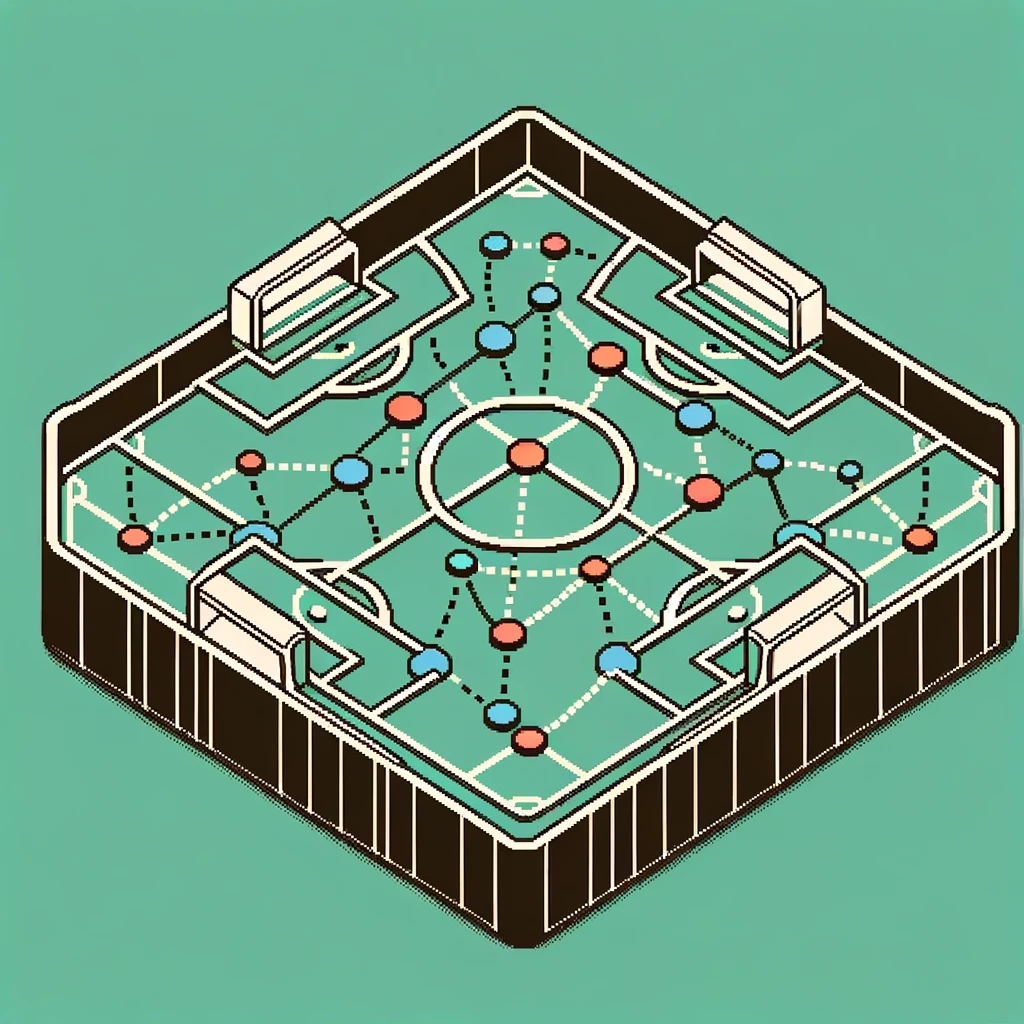
How Network Science is Revolutionizing Player Development and Coaching
In the fascinating realm of soccer, the age-old quest for understanding what makes a team successful continues to evolve. A breakthrough in this quest comes from the field of network science, as detailed in the article “A Multilayer Network Framework for Soccer Analysis” published in Chaos, Solitons & Fractals This revolutionary approach is not just a new lens to view the beautiful game; it’s a game-changer for soccer coaching and player development.
The study introduces a novel methodology for analyzing soccer matches using spatial multilayer networks. This method partitions the soccer pitch into various regions, creating a network that tracks the ball’s movement between these areas during a game. By employing techniques like eigenvector centrality measures, the researchers can assess the significance of each pitch area in the network. Additionally, they introduce three new metrics – leakage, recovery, and switching factor – to quantify possession transitions between layers. This analytical approach was applied to study Spanish teams like Real Madrid, FC Barcelona, and Getafe CF.
So, what does this mean for soccer coaching and player development? Let’s dive in.
Transforming Tactical Analysis
The traditional approach to soccer analytics has primarily focused on individual player statistics, like goals scored, passes completed, or distance run, as well as team-level data, such as ball possession percentages, shots on goal, or fouls committed. This approach, while useful, tends to offer a somewhat limited perspective, primarily emphasizing outcomes rather than the processes leading to them. For example, a team’s possession percentage might tell you how much they controlled the ball, but not how effectively they used their possession to create scoring opportunities or defend against the opponent’s attacks.
Enter the multilayer network approach, a more nuanced method that delves deeper into the complexities of soccer. This innovative technique goes beyond the surface-level statistics and examines the interactions and transitions happening across different areas of the pitch. It essentially creates a map of the game, highlighting the flow and movement of the ball, the interaction between players, and the strategic deployment of team formations.
By analyzing the importance of different pitch areas, this approach provides insights into where a team is most effective or vulnerable. For instance, a team might frequently lose possession in a particular area of the field, which could indicate a need for improved ball-handling skills or a tactical adjustment in that zone. Conversely, a team might be particularly strong in advancing the ball through certain channels on the pitch, which can be leveraged as a key part of their game strategy.
Moreover, understanding how teams transition the ball between different areas is crucial. This can reveal a team’s tactical approach, such as whether they prefer short passes and maintaining possession or long balls aimed at quick counterattacks. Coaches can use this information to refine their team’s playing style or adapt their tactics to counteract an opponent’s strengths.
This multilayer network approach also aids in scouting and preparing for opponents. By analyzing an opponent’s play through this lens, coaches can identify patterns and tendencies in their gameplay. For example, suppose an opponent consistently builds attacks through the wings. In that case, a coach might focus on strengthening their team’s defense in these areas or exploiting potential gaps left by the opponent’s attacking players.
Enhancing Player Development
For player development, this methodology is a treasure trove. Coaches can use the data to tailor training to improve performance in key pitch areas. For instance, if a team frequently loses possession in specific zones, training can focus on retaining the ball in those areas. Similarly, if a player’s influence is central to the team’s network in certain areas of the pitch, training can be customized to enhance these skills.
Real Madrid, FC Barcelona, and Getafe CF: A Case Study

The study’s analysis of teams like Real Madrid and FC Barcelona reveals distinct playing patterns. Real Madrid’s dominance in possession is reflected in their network, with a focus on attacking down the left flank. In contrast, Barcelona’s style emphasizes midfield control. Getafe CF’s network differs vastly, reflecting their direct play style and high-pressure tactics. These insights are invaluable for coaches and players, providing a blueprint of successful strategies and areas for improvement.
Beyond Winning: Understanding the Game’s Complexity
One crucial takeaway is that soccer’s complexity transcends mere ball possession. The interactions and transitions between different areas of the pitch, and how teams adapt to these, are vital. This multilayer network approach provides a comprehensive understanding of these dynamics, enabling teams to develop sophisticated strategies that go beyond traditional metrics like possession or shots on goal.
The Future of Soccer Analysis
This methodology opens up exciting new possibilities for soccer analysis. It promises a deeper understanding of the game, paving the way for innovative coaching strategies and advanced player development techniques. The potential for personalized training programs based on network data could revolutionize how players are groomed for future challenges.
Conclusion
In conclusion, the multilayer network framework for soccer analysis is a groundbreaking tool that brings a fresh perspective to understanding soccer dynamics. It’s an invaluable resource for coaches and players aiming to elevate their game to new heights. By embracing this new methodology, the soccer world can uncover hidden patterns and strategies that could redefine success on the pitch.
For those intrigued by this innovative approach to soccer analysis, diving into the detailed study “A Multilayer Network Framework for Soccer Analysis” is highly recommended. It’s an opportunity to explore the cutting-edge intersection of sports and science, potentially unlocking new pathways to soccer excellence.
Advance Your Soccer Knowledge!
Join the elite circle of soccer aficionados who appreciate the game beyond the field. ‘This Week in Soccer’ bridges the gap between complex soccer analytics and practical application. By subscribing to our newsletter, you’ll gain access to exclusive content, infographics, and forums that will enrich your understanding and love for soccer. Embrace the science and strategy of soccer today. Subscribe and transform your perspective!


